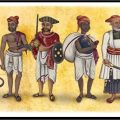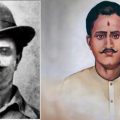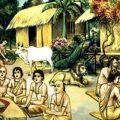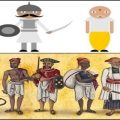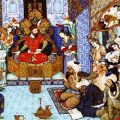How Chaturvarna Benefited Society and How British Vilified It to Loot Wealth
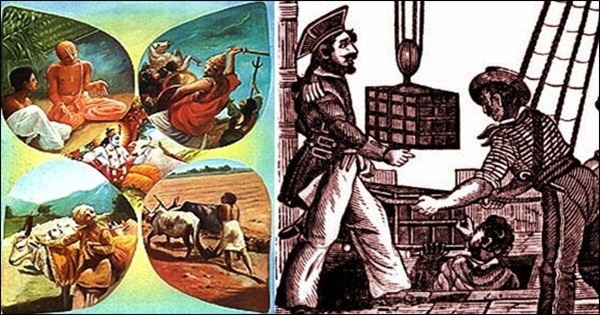
Continued from Part 1 (Click here to read Part 1)…..
Chaturvarna is often blamed and vilified. It is abused as the root cause of caste division in India. Actually this vilification was done by the British.
We need to ask some questions. If the system was bad, why nobody “revolted” in India for 1000’s of years? We do not have even 1 story of people complaining against “Chatrurvarnashrama” from ancient India. Why? Why would people tolerate a discriminatory system for 1000’s of years?
The fact of the matter is, Chaturvarna is misunderstood by us. So, we are complaining about it, as an “Historic injustice”. But people, who lived under it never complained. They never complained because, they understood it right and It was very beneficial to them. Let us see, how it was beneficial.
I have already explained, Chaturvarna was a taxation policy (Click to read the published article). “Varna” means color. Chaturvarna means “4 color”. In-fact “Chaturvarna” was just a color coded taxation policy. The 4 colors were as follows.
- A) White -> Indicates selfless service -> Brahmins (Dedicated Social service volunteers)
- B) Red -> Indicates highest personal sacrifice, to offer ones own blood for nation-> Kshatriya (Soldiers)
- C) Yellow -> Gold, wealth. Creating wealth for nation -> Vysya (Business/traders)
- D) Blue -> Vastness like sea/sky -> Everybody else . It means, all other Workers in society (Farmers/Artisans, includes all other profession).
Note, in any religious worship, Hindus use 3 colors, white (clothes to indicate purity), Red (kumkum indicating sacrifice) and Yellow (Haldi as prosperity/sumangal). Flowers of these colors are also chosen and considered holy to use. The custom is associating with praying for well being of these groups, so that prosperity of nation flourishes. Widowed women used to wear “white clothes” to indicate they moved away from material world to social service. This social service is done to get purity of mind, so that, they can get rid of bad karmas and could attain “moksha” or liberation from rebirth. Since this higher order benefit was shown, there was no question raised on logic nature of Varnashrama.
The 3 varnas (depicted as forward class) was essential order of selfless serving of society/nation. Brahmin/white group at highest level (As entire family and generations are getting dedicated to selfless serving). Kshatriyas/red group at next level, as men used to sacrifice their lives for country. Vysyas at third level, as they had to dedicate wealth to nation, although it was under their control all the time. 4th varna was considered as least, as there was immediate reward for value delivered (very less selflessness).
The taxation policy was the “crux”/ center piece of “Dharma” ensuring the prosperity of ancient India. It ensured, nobody control all aspects of society, to become a super human (dictator) and start exploiting others. It stopped centralization of power, there by regulating corruption/hoarding. Because of this Chaturvarna policy, wealth was getting distributed in society and ensured “fairness” for everybody. This “fairness” was the strength of “India”.
Actually Muslim invaders, did not understand this mechanism. They thought, “Dharma” means “religion”. So, they attacked temples and religious places to destroy “India”. But largely they could not make an impact in society. In spite of large scale temple destruction and forced conversions, India flourished. Temple destruction or forced conversions did not affect the Chaturvarna social system. That is the reason, India remained rich (was richest nation in world), even during Mughal rule.
British came following Mughals. They were careful in studying the mistakes of Mughals. In fact, they studied Indian practices from “Business angle” and they zeroed in on “Chaturvarna”. They decoded that, “Chaturvarna/tax policy” was the core of Indian “Dharma”. So, to destroy India, they started to strategize on how to attack its core/strength. By successfully disrupting the Chaturvarna system, British could centralize revenue collection at one place and then loot it easily. India became poor at an astonishing rate under British rule of 200 years.
Let us analyze, how Chaturvarna was contributing to the prosperity of India.
1) Brahmins were an intellectual class funded from society. They were exempted from tax, capitol punishment and military duty (they were barred from holding any weapon). They were much like modern day university system (Govt funds 1000’s of crore as education expense in the hope that, knowledge will drive economy). To get the tax benefits, a Brahmin family had to dedicate themselves for social work and were forbidden from hoarding personal wealth. The donations/grant given to a family were meant for education or for social work. They stayed in social housing (agraharas built and owned by state). Brahmins were prescribed with 5 types of daily rituals (kind of donations, like giving food for visitors (annayajna), knowledge (jnanayajna), devayajna, pitru yajna etc..). This ensured, Brahmins spend most of their wealth back to society, instead of hoarding.
No wealth, apart from knowledge, was transferred from father to son. Most Brahmins remained poor because of this policy. But they enjoyed highest respect in the society for their “selfless service”. It was a tough path and not meant for ordinary people. People who enjoyed and considered intellectual benefits (higher order mental enjoyment in-lieu of material benefits) chose this path. Brahmins were allowed to influence policy decisions for all other people. This was done, because, Brahmins couldn’t benefit personally and hence all the policies they decide were always in the best interest of society/nation. Non hoarding rule eliminated conflict of interest (Not able to invest wealth in land or gold blocked intellectual corruption by Brahmins. Today many media houses and Luteyens are engaged in intellectual corruption for personal monetary gains, there by derailing society). Non hoarding rule also ensured Brahmins will be forced to build their assets “intellectually”. So, if any grants were given, it was getting converted into building knowledge assets. This is the reason, most contributions in education, science, literature, music etc were done by Brahmins. They were custodian of knowledge (symbolically called as Vedas). They were given time to build and enrich it.
2) Soldiers, were paid from exchequer. Families were dedicated to this national security. Since, the salary payment was perpetual, the families never worried about hoarding wealth. They always lived in the fortification or at the borders. They were highly mobile and could not hold any land or gold (insecurity of looting in war/conflict). Threat of war was continuous and there was no point holding wealth. So, soldiers always banked on king to meet all their expenses. For this perpetual salary benefit, Kshatriyas had to pledge their blood for nation. They took oath of fighting till their last breath and their family continuing the tradition. Defection/disloyalty attracted capital punishment. Judgement was instantaneous. The valour (fighting spirit) was very much appreciated. Hence loyalty and physical strength were the assets for Kshatriyas.
So, a Kshatriya family was forced to invest their wealth in building physical strength, fighting skills and loyalty relationships with rulers/nationalists. They always invested in building relationship with ruling monarch (so, loyalty was never a question). Kshatriyas could not hoard wealth either in land or in gold. So, they were performing their duty at highest optimal level (with zero corruption). Hence national security and policing were very effective. This ensured muscle power was never misused and corruption was checkmated at its bud.
3) Vysyas were given the task of creating wealth. This creation of wealth was for nation and not for personal gains. So, Vysyas were given trade/business licenses, but were prohibited from holding lands or recruiting personal armies. Since possession of gold carried highest risk (threat of robbery), there was an automatic cap. Royal treasury was the only “guarded bank”. So, excess gold had to be deposited with “treasury” for safe keeping. Because of these limitations, Vysyas were forced to invest capital in creating wealth for society.
There was no paucity of funds for “Industry”. Capital was always available. So, interest rate was very minimal (like in Japan today). If Vysyas were unwilling to deposit cash with treasury or were unwilling to invest in industry, the only other option left out was to give away in charity. So, Vysyas were big donors to temples. To reduce risk of robbery, they lent money at very affordable interest rates or donated to social causes. This ensured there is no corruption for individual profiteering and black marketing. Taxation was individually negotiated, depending on market demand or amount of profits generated. So, state was generating highest revenue collection from Vysyas. They never complained, as there was no opposition to pay taxes (no motivation to do tax evasion). The bench mark of sacrifice from Brahmins and Kshatriyas was good enough to placate grievance of tax burden from Vysya community.
4) Shudras or general class (all other workers) were the common group. Note, In India, farming was the primary employment sector (employing 60-70% of population). But there was no Varna created for them. Be it farmer or an artisan or simply a worker rendering service (for ex, a clerk), they were all treated in one fashion. They were allowed to hoard their wealth in land or in gold, but taxed with same rate (there was no carrots for choosing one work over other). Hoarding was temporary and if required, king could be collecting back the hoarded wealth by raising tax rates during distress.
Land ownership was always with state (so land could be taken back by king, if required). Only leasing rights were given from state. The lease was transferable. There was also a possibility of sublease. One respectable guy used to lease land from king and he was given the task of sub-leasing land to other people in a hamlet/village. As there was no concept of ownership, how much one will lease land was dependent purely on how much one could productively put it to good use. Since land was taxed separately, nobody leased more than they needed or could afford to pay taxes. This ensured there was abundant supply of productive land.
Since there was no ownership of land, land was not used for guaranteeing a loan. Loan was hypothecated based on future incomes a family could generate. This future income was called as “Runa”. Loan was granted based on a family’s collateral. The family members were obliged to inherit the “obligation” and repay the loan with future incomes. This “Runa” is different from “slavery/Jeeta”. Since there was abundant supply of cash (liquidity was high), there was no need of guaranteeing a loan through land or gold. Family respect and standing in society was paramount and was good enough to guarantee a loan. There was no corruption or black marketing of loan. Interest was low and it was easy to repay. There were no time constraints too, as lenders knew borrowers and family was the collateral. Some repayments ran across generations.
Since, there was no artificial demand, there was no corruption. Since there was no black marketing, cost of financing was cheap. Low cost of financing means, people could take up risky ventures easily. Today, all of these factors are just reversed. High cost of loan, lot of demand for collateral, complicated procedures, heavy repercussion on default etc has instilled a sense of fear and Indians are risk averse today. Innovation and Business suffer due to this. End result, India is forced to import products and services at high cost as people are not ready to invest capital locally.
As, corruption was minimal in those days, it was easy to interact. Transaction cost was minimal and doing business in India was very easy. As business was smooth and transaction cost was very low, India was highly competitive. Trust level in society was standing at its highest point.
Society was corruption free. Crime rate was very low. So, India flourished like anything. It was difficult for others to emulate, Indian situation. All these were encapsulated as “Dharma”. Hence, “Dharmo Rakshathi Rakshithaha” was the slogan, which means, ‘Protect righteous practices and you will be protected’.
Britishers, were corrupt. They wanted to take out wealth from India. To take out wealth from India, they had to divert cash (which was distributed at peoples hand on the ground). To divert cash, they had to centralize cash flow. They started tweaking business practices and started to introduce hoarding. They started to corrupt businessmen by saying, they could hoard gold in foreign trade. This was a new thing. But this corruption was limited to business community. They realized that, they should capture land and induce people to hoard wealth in land. Only hoarding wealth in land would corrupt Indian society. So, they started capturing land and started strengthening Zamindar system (a system introduced by Mughals to benefit their loyalists, by appropriating locals land).
A Zamindar was given “land ownership” and was made super rich artificially. The moment “ownership of land was granted”, people could hoard wealth in it. This hoarding sucked money out of free circulation. Limited supply of cash and land started affecting life of ordinary citizens. the limited cash created artificial demand and forced people to work for “money”. The throttled cash, created bad incidences in peoples personal life. To avoid future occurrences, people started to hoard cash, further restricting supply. This depleting cash supply created supply-demand gap. As the supply-demand gap widened, interest rate zoomed (creating complicated and expensive interest types). This high cost of loans, means, people will naturally avoid them. If a family has to avoid loan, they have to create their own reserves. As people wanted to create reserve at a faster rate (without any limit), it led to “greediness”. This “Greediness” created widespread corruption in society.
As this “greediness transformation” was happening at one end, Britishers started a propaganda exercise that, Zamindari system (which was bestowed in the control of few forward castes) was responsible for hardship on people. They even did a propaganda that, Zamindari system was based on caste system and that caste system was causing all hardship to people. People very well understood that, shortage of free flowing cash was creating hardships. But due to propaganda, they thought, “rich” people were responsible for the hardship. They associated degraded religion for it. They could see more and more rich vs poor divide in society. People could easily see, rich were hoarding money in their land assets.
As the rich hoarded their wealth, they were blackmailed by Britishers. High taxes were levied on Zamindars in the name of security. Zamindars and business monopoly were the link for centralizing cash flow. It created aggregated nodes. Britishers looted these nodes with high taxes (ordinary people could not sense the British loot, as they always paid to their landlords). Armed gangs (like the dacoits shown in movie Sholay) were hired by Britishers to put fear of loot and insecurity among Zamindars (quell any rebellion against Britishers). Anger of ordinary citizens were fanned by Britishers against their land owners (Zamindars), while Britishers became the end beneficiaries.
Verify any land grant in Indian ancient inscriptions. Land was always owned by the reigning deity (like Shiva/ Vishnu). So, what was given in grant was not ownership right, but usage/leasing rights. If only lease rights were given by Hindu kings under Varnasharma system, there were no question of hoarding wealth in land or aggregation of land with “Zamindars”. Hence, there was no exploitation. Exploitation started with creation of Zamindars by Mughals and then system was expanded by Britishers. In fact, land was confiscated back from ordinary people (using the class that, land ownership lies with state) creating large pool of landless laborers. The situation was very alarming in Bihar, Bengal etc. The situation led to “Bhoo daana chaluvali“, where many Zamindaars were pursued by Vinobha Bhave and others during Indian freedom movement to give back the land ownership to labourers. The problem still persists as naxal movement.
With this cunning policy, British design of looting India was successfully completed and “Chaturvarna was made the villain”.
Allowing “hoarding of wealth” was the root cause of corruption. Hoarding creates centralized cash at one end while creating shortage of cash for common people. This is nothing but creation of artificial demand and supply gap. This gap gives unprecedented control to Bankers, who dictate everything. In modern world, this is what is happening.
Featured image courtesy: Bharata Bharati and hinduperspective.com

